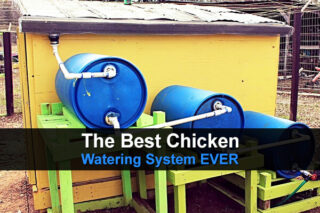Estimated reading time: 9 minutes

On a homestead, there is no time more exciting than when livestock first arrives. When animals begin to fill the barn, pens, and hutches, it makes newbie homesteaders feel like they have finally arrived. Unfortunately, a well-crafted plan to grow and raise your own groceries can rapidly turn into an epic failure if you make one of many common livestock husbandry mistakes.
You can prevent a substantial loss of money and the heartache of watching livestock suffer by investing some time learning proper husbandry skills before buying a single animal. Both local laws and deed restrictions can also greatly impact your homesteading livestock plans, even if you live in a rural area where ranching is commonplace.
1. Underestimating the Overall Cost
You may know exactly how much you are paying for a particular animal, but do you know the full cost of keeping it? Before even considering purchasing small livestock, learn how long it takes the animal to go through a bag of feed in each season – it can vary greatly. If purchasing a goat, horse, or cow, for example, you must also factor the cost of hay into the equation. Straw or some type of bedding will also be required to house the animal – it must be replaced when soiled or the livestock can become gravely ill.
If the animals are not free-ranging or if their water source can freeze, the added cost of watering the livestock must also be factored in. Even if you have “free” well water, the electricity bill could increase substantially if forced to water large livestock all winter long.
Do not forget to consider medical care expenses for the livestock as well. Treating the animals naturally is often a part of homesteading, but the herbs, roots, essential oils and carrier oils typically used in natural medicine all come with a price tag. If a situation with an animal becomes extremely serious or is potentially contagious, a vet may have to be called – and expensive treatments or surgery required in order to save the animal.
2. Not Researching Legal Issues
Don't assume that simply because you live in a right-to-farm state you can keep any animal, breed, or number of animals you want in an incorporated area. The guidelines governing in-town farming vary greatly and can sometimes be contingent upon official approval from a local governing body or impacted by neighbor complaints.
Although you can usually keep any type and number of livestock desired in rural areas, never assume that is the case. When looking for our dream survival homestead, one of the properties up for consideration had a deed restriction against the keeping of pigs. That was extremely odd for our country where no government permit office or zoning laws even exist, but the unexplained restriction was on the deed, anyway.
3. Underestimating the Space Needed for Your Animals
Ten acres might sound like a lot of land to anyone who did not grow up in the country, but that space is gobbled up quickly when a home, garden, and barn are placed on the property. Sustainable living frequently means allowing livestock to garner as much of their diet as possible off the land.
A single horse needs a bare minimum of one acre to have enough pasture to sustain it, but two acres is far more realistic. A cow and her calf need two acres to graze in order to sustain their body weight. Planning on baling your own hay to save money? It takes 50 acres to garner 100 square bales of hay. That might sound like quite a few bales, but a cow eats about 2 square bales of hay per day.
4. Not Taking Steps to Improve the Pasture
All grass is not created equal. A large open space might look like a pasture, but that does not mean it is – at least not in its current state. It is possible to turn nearly any field or even hilly and wooded area into a quality pasture that will fulfill the nutritional needs of livestock, but doing so takes both money and time – emphasis on the time part.
5. Not Inspecting Animals Before Buying Them
An animal might look healthy, but that does not mean it is. Buying livestock at an auction or from a commercial agricultural store can be an enormously risky endeavor. If you do not know how to inspect the animal for health and breeding qualities, you'll have to take the word of the fast-talking auctioneer trying to make a quick buck or the teenage cashier working at the spring chick section of an agriculture store.
Buying from a local breeder is generally the best option, especially when the parents of the young livestock are on site. But again, not knowing how to inspect the health status of the animal yourself forces you to rely solely upon the seller for this vital information.
6. Getting the Wrong Breeds for Your Climate
Some livestock breeds are better suited than others to live in specific areas. Never assume that livestock available to buy in your region is particularly suited to the are.They usually are, but not always. Buying a cow that has thick or long hair could cause heat stroke during the hot summer months in some climates. A pig with short or thin hair will be difficult to keep in regions prone to frigid winters.
7. Underestimating the Cost of Heritage Breeds
Traditional breeds of all animals are on threatened or endangered livestock lists. Factory farms have replaced family farms to a substantial degree all around the country. The growing movement to keep and breed heritage livestock is helping to bring back some breeds, but it can be difficult for first-time keepers who hope (possibly need) to butcher the animal for meat in two years or less.
Heritage breeds are kept naturally and not infused with injections to help them bulk up quickly. They require more time to reach butcher weight, which makes them more expensive to raise due to enhanced food costs when they are housed and wintered over for longer periods of time. Helping save heritage breeds is a worthy effort to be sure, but the added expense and wait time for meat must be carefully factored in when spending money and using up barn space to keep them.
8. Providing Inadequate Housing
All livestock need some type of a shelter to protect them from the weather, but it needs to be a large enough shelter. Not only is it cruel to keep animals in a confined space (doing so will increase the chances of illness spreading via contact with feces), it increases the chances of a contagious disease overtaking a herd. Large animals in a herd or sounder (group of pigs/hogs) can push smaller or younger ones away from feeders and waterers and injure each other through kicking or biting when they are cooped up in far too small of a space.
Here are some guidelines to follow:
• Cows do not necessarily need a barn to live in, but they should be offered a shelter of some type to get out of the rain and snow, and to shade them from the sun. If housed in a barn, cattle should be granted a minimum of 50 square feet of free movement space in a single or shared stall environment.
• Horse stalls should be constructed to meet either 12×8 or 10×10 foot dimensions.
• Goats and sheep need 20 to 25 square feet of free movement space per animal in their pen. Goats are notorious climbers, so if you don't teach the goats to free range (although you should if you have a large acre homestead) use small-gauge hardware cloth or high tensile wire backed by wood or metal support posts to keep them in their designated space.
• Poultry breeds need at least three but up to six square feet of free movement space in their pens. Hardening the pens from predators is the most difficult aspect of keeping poultry. A mink, weasel, or even a raccoon can wipe out an entire flock in just one night. Use at least two step latches on coop and run doors to deter raccoons. Chicken wire is great for keeping chickens in, but lousy when it comes to keeping predators out. Use hardware cloth on the poultry run and for added security from predators. Line the floor with hardware cloth and trench the cloth one foot out from both the coop and run to deter digging predators. A mink can slink through a hole the size of a quarter. Routinely inspect the coop and run for a stretched wire or weakened wood that could permit a mink to make its way inside.
• Pigs should have at least 25 to 50 square feet of free movement space per animal. Hogs will rut and push on their pen boundaries relentlessly. Investing in metal hog panels should not be a waste of money. Hunting for a hog in the woods is not fun and not always successful.
9. Keeping Larger Animals Than You Can Handle
Newbie homesteaders who have not had any experience keeping livestock might be fooled into thinking cows are always docile animals. Just like horses, they can–and do–bite. Cows do not rear up and kick like horses, but they can (and again, do) ram their keepers, sometimes even causing cracked ribs, if they become food aggressive or panicked.
If your animal husbandry skills place you into this category, consider keeping medium livestock like goats or sheep first, or investing in Dexter cattle, a miniature breed that still will earn their keep in tasty beef and a steady supply of milk. Pygmy and Nigerian dwarf goats are ideal meat and dairy breeds to keep on suburban and small homesteads.
10. When Butchering, Neglecting To Use and/or Preserve Every Part of the Animal
Butchering costs of livestock vary by location, but should always be factored into husbandry expenses when purchasing livestock or adding to the animals already being cared for on the homestead. Learning how to butcher your own livestock will be a significant money saver over time and does not necessarily require expensive equipment. If you have the animals butchered commercially, consider letting the butcher know you want to keep the hide, bones, head, etc. of the animals.
Tanning your own hides and making stock from the bones, and even learning to enjoy dining on head cheese and tongue (they actually can taste delicious when prepared properly) will increase the value of keeping the animal. Meat preservation typically requires pressure canning and/or smoking. Factor both the cost of purchasing the necessary equipment (keep costs low by building your own smoker!) and space to store the processed meat, into your homestead husbandry plans.











Remember, a mediocre animal will live forever, but the best ones are just looking for a way to get hurt or die. Better have a budget for replacements.
2 bales of hay a day for 1 cow?! You are seriously overfeeding your animal and wasting hay. I have had milk cows/steers for a very long time now and will feed 2-3 flakes of hay out of a 60 lb bale twice a day for 1 cow. With my milk cows, I will feed a dairy ration when they are milked along with some hay in the feeder to keep them happy and standing there (I milk by hand). Cows can and do kick-unlike horses who kick back, cows will kick forward and around. I keep Dexter cows and can attest to their friendly, docile nature however they are animals and although small can hurt you. As to 50 acres to get 100 bales of hay? That’s a pretty bad hay field- I can get 40 small 60lb bales off of a 2 acre field here in SW Colorado.
Thank for settling is article straight. It sounded far fetched to me ad well
I agree, the reported yield of hay for 50 acres is WAY off!